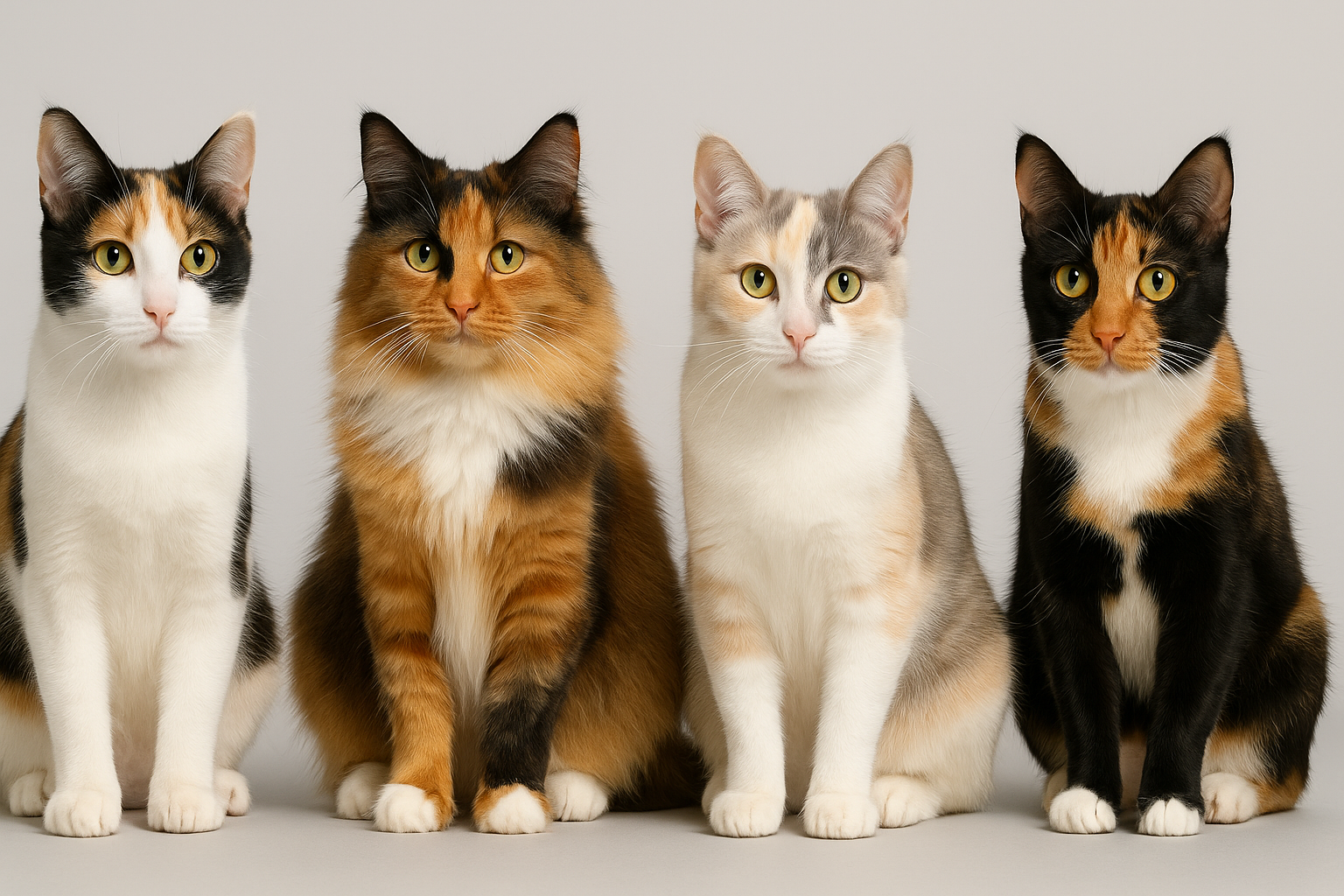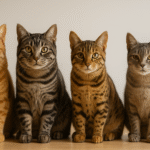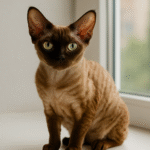Calico cats are some of the most visually striking felines you’ll ever meet. Known for their distinctive tri-color coats—usually a mix of white, orange, and black—these cats aren’t a specific breed, but rather a unique color pattern found in various breeds. Whether long-haired, short-haired, or somewhere in between, a Calico’s patchwork beauty turns heads wherever she goes.
But there’s more to Calicos than just their good looks. They’re often described as bold, spunky, and fiercely independent—with a dash of sass. This guide explores what makes Calico cats so special, from their fascinating genetics to their personality, health, and more.
Quick Facts About Calico Cats
- Origin: Not breed-specific; coat pattern occurs in multiple breeds
- Breed registries: Pattern accepted in Persian, Maine Coon, American Shorthair, etc.
- Weight range: 6–12 lbs
- Lifespan: 12–16 years
- Coat: Short, medium, or long hair
- Colors and patterns: White with orange and black patches (or gray/cream for dilute calico)
- Eye color: Usually green, gold, or hazel
- Grooming: Varies by breed (generally low to moderate)
- Activity level: Moderate
- Affection level: Varies; often bonded to one person
- Vocality: Medium to high
- Good with children: Yes, if socialized
- Good with other pets: Depends on personality
History & Origin
Calico cats aren’t a breed, but a color variation that occurs due to complex genetics linked to the X chromosome. Because of this, nearly all Calico cats are female. In extremely rare cases, a male Calico may be born—but it’s usually due to a genetic anomaly, and these males are often sterile.
Since Calico is a color pattern, you’ll find it in many breeds including the American Shorthair, Maine Coon, Persian, and even Ragdoll cats. These gorgeous felines have been celebrated in folklore around the world—especially in Japan, where they’re considered lucky charms!
Coat Patterns: Calico vs. Tortoiseshell
It’s easy to mix up calico cats with tortoiseshell cats, especially since both feature orange and black.
But there’s one major difference: Calicos have white in their coat, while torties typically do not. Calico patterns are more patchy and high-contrast, while tortoiseshell coats blend the colors together in a mottled, swirled mix.
Some cats show a mix of both styles. These are sometimes called “calitorties”—a playful term for felines that fall somewhere between the two patterns. You might also come across a dilute calico cat, where the bold black and orange patches are softened into gray, cream, and soft peach. These pastel-coated beauties have all the charm of traditional Calicos, but with a more muted, watercolor-like look.
Calico Cat Personality
Calicos are known for their bold and quirky personalities—many owners describe them as strong-willed, playful, and sometimes a bit sassy. While not scientifically proven, this reputation is so common it has its own nickname: “calico attitude.”
Each Calico cat’s personality will depend on her breed, upbringing, and socialization. Some are cuddly lap cats, while others are independent adventurers. What they all have in common is a fierce sense of individuality—living with a Calico is never boring.
Activity & Play
Because Calicos occur across many breeds, activity level varies. A calico Maine Coon cat or calico Persian cat will have different energy needs than a calico tabby cat mix. Provide toys, scratching posts, and vertical climbing spaces to keep them enriched and engaged. Most Calicos are curious and clever, so puzzle toys can be especially rewarding.
Interactive play is a great way to bond with your Calico. These cats often enjoy feather wands, climbing trees, and anything they can stalk or chase. Rotate toys regularly to keep things interesting, and provide cozy window perches for daily entertainment.
Health & Lifespan

Wondering how long Calico cats live? Most have an average lifespan of 12–16 years, depending on their breed and care. Because Calico is a color pattern, not a health-affecting gene, they don’t have any special medical concerns related to their coat.
The rare male Calico cat may face additional health risks if born with Klinefelter Syndrome (XXY chromosomes), which can impact their lifespan and fertility. But these cases are extremely rare—about 1 in 3,000. As with any cat, regular vet checkups, high-quality nutrition, and an enriched home environment go a long way toward a healthy, happy life.
Grooming & Shedding
A long-haired Calico cat will need regular brushing, while a short-haired Calico may only need weekly maintenance. Use a gentle slicker brush and check behind the ears, under the legs, and along the tail where mats can form. Regular brushing also helps with shedding and reduces hairballs.
Calico cats with medium to long coats may benefit from seasonal grooming sessions during heavy shed periods. Make brushing part of your bonding routine with treats and praise to help build trust. Most Calicos adapt well to grooming if started early.
Nutrition & Diet
There’s no specific food required for Calico cats, but their diet should match their age, activity level, and any breed-specific needs. A Calico Ragdoll cat or larger Maine Coon mix may need extra calories compared to a smaller American Shorthair.
Choose a high-protein cat food with real meat as the first ingredient. Wet food can be a great option to support hydration, and a combination of wet and dry may work well for most Calicos. Fresh water should always be available—some Calicos even enjoy pet fountains!
Family Compatibility
Calico cats can make wonderful family pets, especially when properly socialized. Many form strong bonds with one person, but still enjoy the company of older kids and calm dogs. Their strong personalities may not suit households with hyperactive pets, but every Calico is unique.
These cats thrive in homes where their independence is respected and their environment is enriched. If you’re looking for a bold, eye-catching companion with a touch of spice, a Calico might be a perfect match.
Recommended Supplies
Along with a sturdy litter box and soft bed, your Calico will appreciate a high-quality scratching post and interactive toys. Long-haired Calicos may also benefit from grooming wipes or detangling spray.
Because Calicos are intelligent and occasionally food-motivated, puzzle feeders or treat-dispensing toys are a great way to engage their minds. Elevated perches, cat trees, and sunny window sills are must-haves in a Calico’s ideal setup.
Calico Cat FAQs
Are Calico cats always female?
Yes—almost all Calicos are female due to the genetics of coat color, which are linked to the X chromosome.
Can Calico cats be male?
Male Calico cats are extremely rare (1 in 3,000) and usually have a genetic condition called Klinefelter Syndrome, making them sterile.
How long do Calico cats live?
Most Calico cats live 12 to 16 years, depending on breed, genetics, and overall care.
What is the difference between a Tortoiseshell cat and a Calico cat?
Calicos have white in their coat, while tortoiseshell cats have a mottled mix of orange and black with little or no white.







